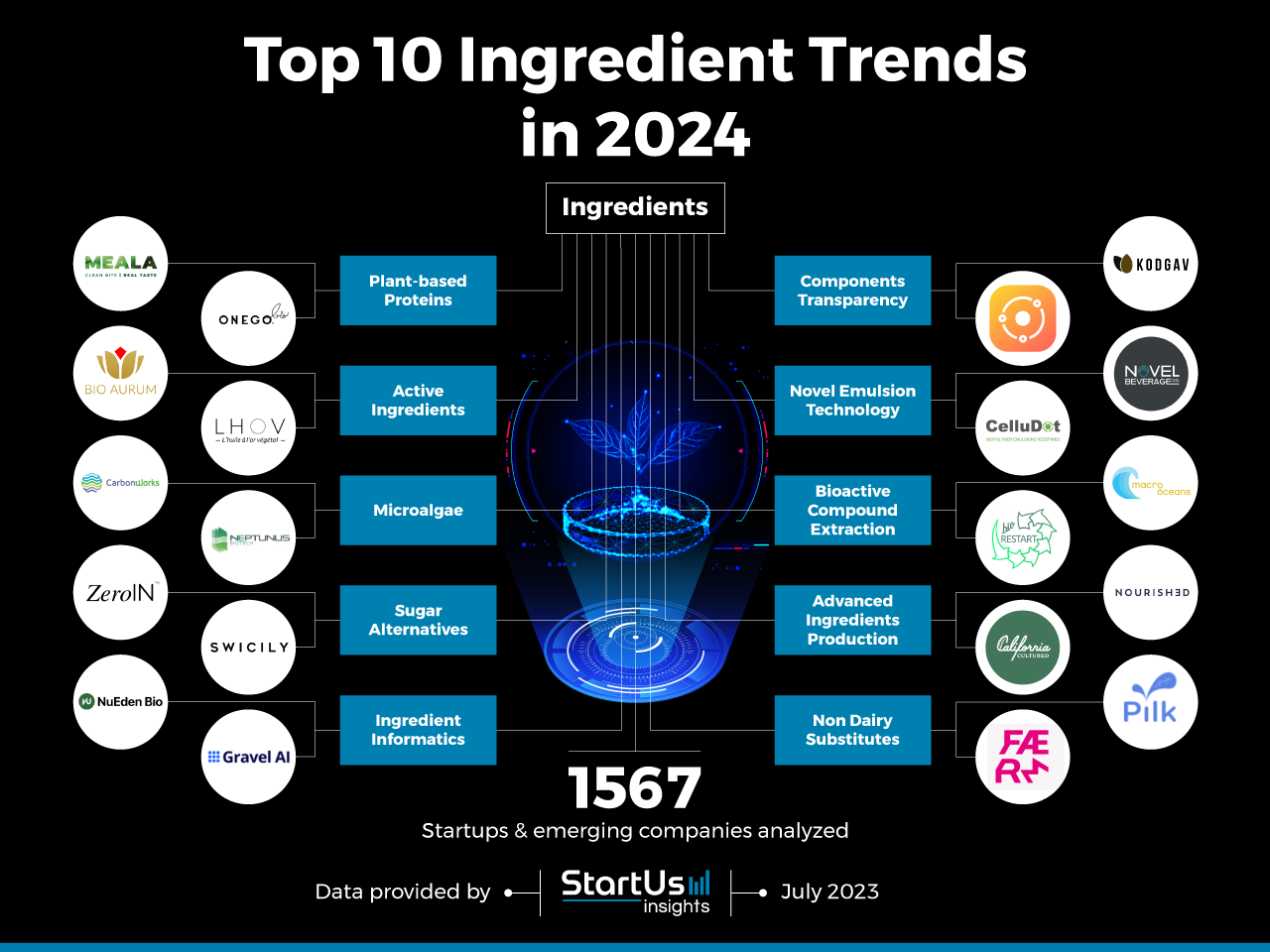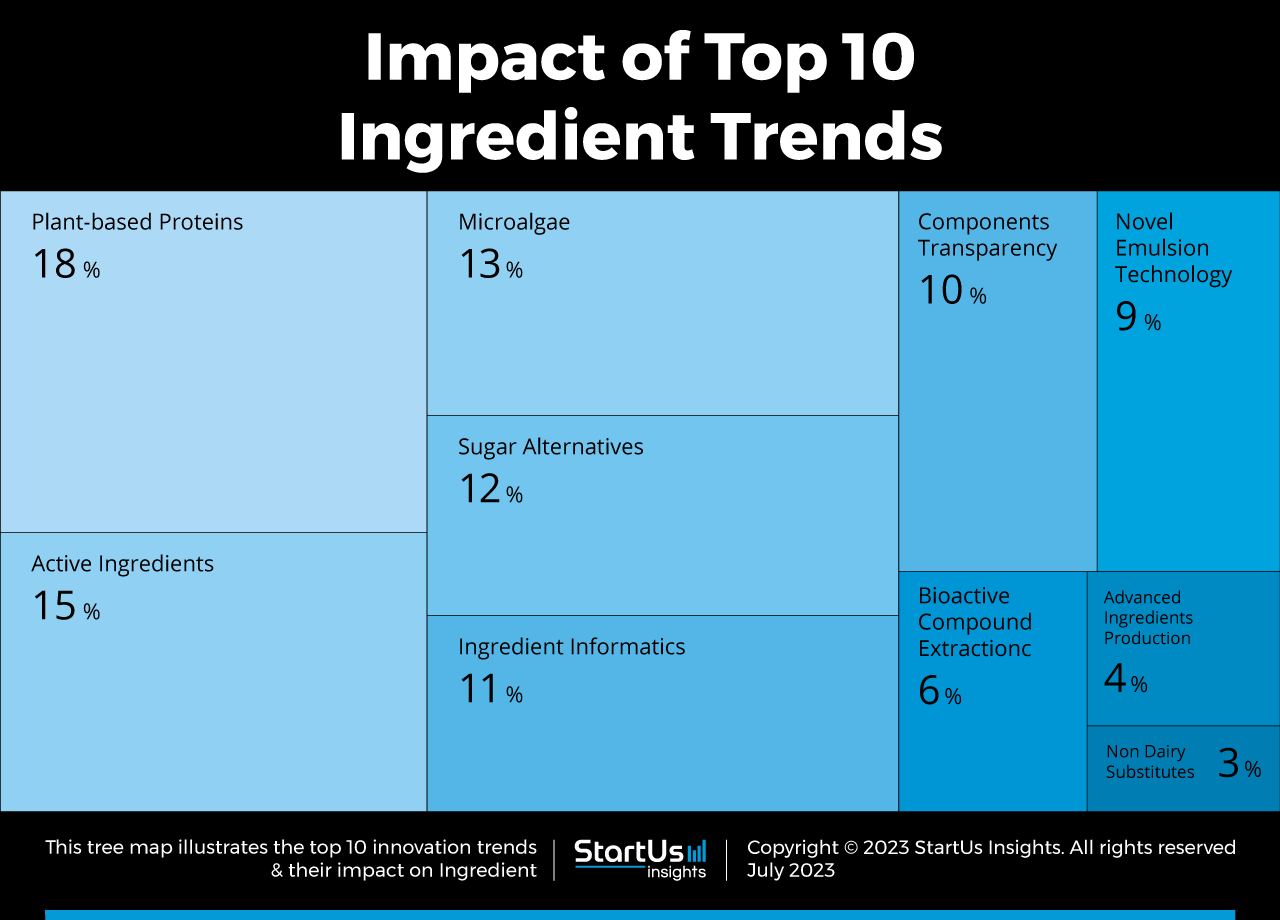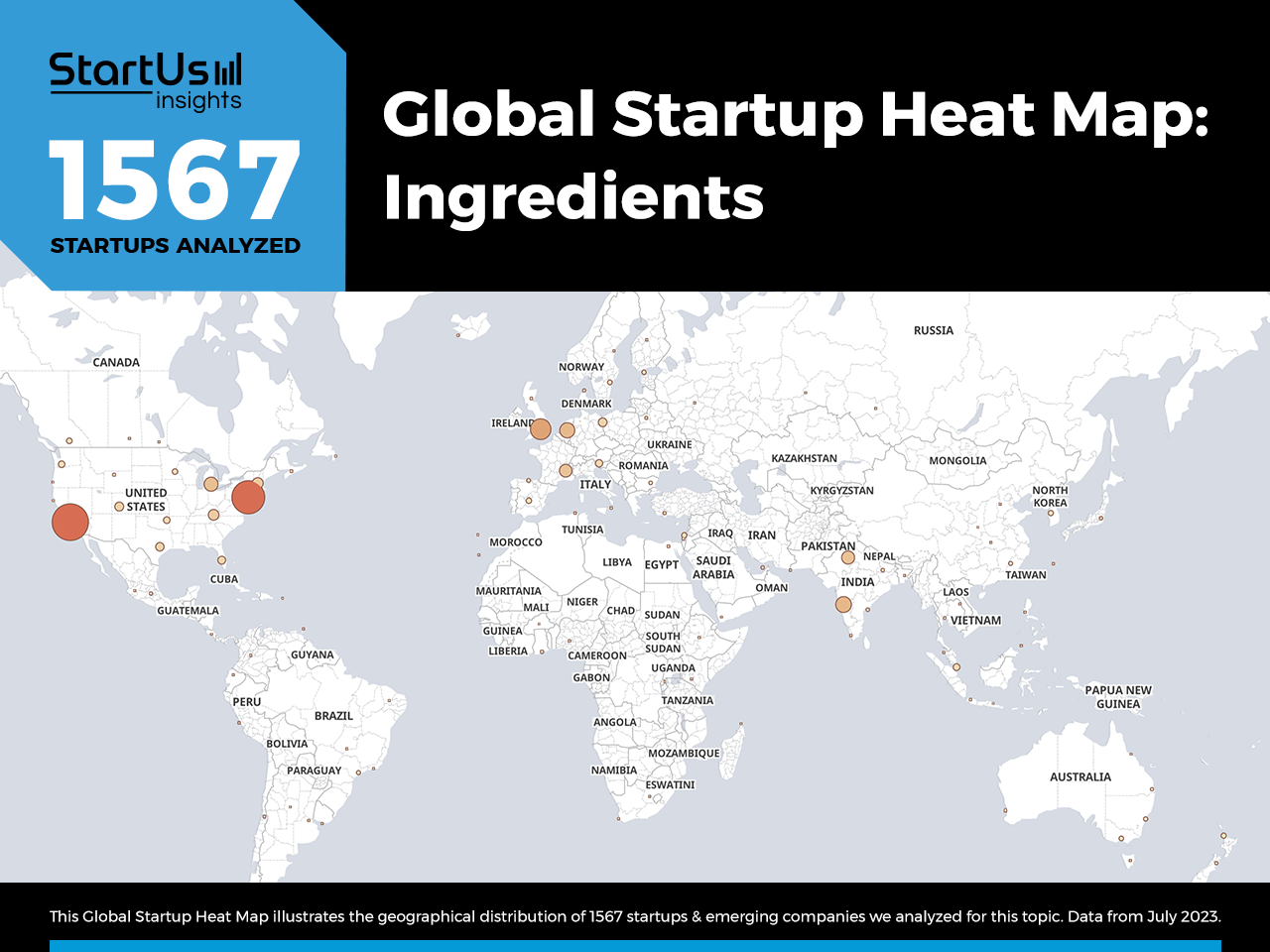The ingredients industry adapts to rapidly evolving consumer preferences. Technological advances are helping businesses keep up with the changing landscape and meet emerging market preferences. Through new emulsion technologies, the extraction of bioactive compounds, the production of advanced ingredients, and the development of non-dairy substitutes, the industry strives to deliver products of high quality. They also incorporate advanced properties, promote sustainability, and enable personalization. This report examines the most influential ingredient trends and how they advance manufacturing industries.
Innovation Map outlines the Top 10 Ingredient Industry Trends & 20 Promising Startups
For this in-depth research on the Top Ingredient Trends and startups, we analyzed a sample of 1567 global startups & scaleups. This data-driven research provides innovation intelligence that helps you improve strategic decision-making by giving you an overview of emerging technologies in the ingredients industry. In the Ingredient Innovation Map below, you get a comprehensive overview of the innovation trends & startups that impact your company.
These insights are derived by working with our Big Data & Artificial Intelligence-powered StartUs Insights Discovery Platform, covering 3 790 000+ startups & scaleups globally. As the world’s largest resource for data on emerging companies, the SaaS platform enables you to identify relevant technologies and industry trends quickly & exhaustively.
Top 10 Ingredient Innovations in 2024
- Plant-based Proteins
- Active Ingredients
- Microalgae
- Sugar Alternatives
- Ingredient Informatics
- Components Transparency
- Novel Emulsion Technology
- Bioactive Compound Extraction
- Advanced Ingredients Production
- Non-Dairy Substitutes
Tree Map reveals the Impact of the Top 10 Trends in Ingredients
Based on the Ingredient Innovation Map, the Tree Map below illustrates the impact of the Top 10 Ingredient Industry Trends in 2024. Startups are developing advanced solutions to meet the increasing demand for sustainable societies. Plant-based proteins and microalgae provide alternatives to animal-based ingredients, while the active ingredients trend advances the ingredient’s functionality. Sugar alternatives, like stevia, monk fruit, and erythritol, also meet the demand for natural and low-calorie sugar alternatives.
Ingredient informatics and components transparency trends utilize advanced technologies for ingredient research and development purposes and allow consumers to get detailed information about the ingredients. Further, novel emulsion technology enhances texture and flavor, while bioactive compound extraction minimizes the need for high temperatures and large amounts of solvents. Finally, non-dairy substitutes innovate in the ingredient formulation and processing techniques to provide plant-based milk, cheese, and yogurt alternatives.
Global Startup Heat Map covers 1567 Ingredient Startups & Scaleups
The Global Startup Heat Map below highlights the global distribution of the 1567 exemplary startups & scaleups that we analyzed for this research. Created through the StartUs Insights Discovery Platform, the Heat Map reveals high startup activity in the US, followed by the UK and India. Below, you get to meet 20 out of these 1567 promising startups & scaleups as well as the solutions they develop.
These ingredient startups are hand-picked based on criteria such as founding year, location, funding raised & more. Depending on your specific needs, your top picks might look entirely different.
Top 10 Ingredient Innovations in 2024
1. Plant-based Proteins
Plant-based proteins are gaining popularity due to increasing environmental, health, and ethical concerns related to animal-based proteins. Unconventional sources like quinoa, hemp, algae, lentils, chickpeas, fungi, and insects offer rich protein content and additional nutritional benefits. A significant challenge for this trend is replicating the taste and texture of meat, which businesses address through food processing methods like extrusion, fermentation, and texturization.
Further, innovations in precision fermentation allow for the production of proteins identical to those in animal products. Nutritional optimization is also a focus, with companies blending different plant proteins or fortifying them to create a complete amino acid profile. This also delivers personalized nutrition as products are developed to cater to specific dietary needs or preferences, such as gluten-free or high-protein diets.
MEALA develops Bio-based Meat Alternatives
Israeli startup MEALA makes bio-based meat alternatives using plant-based protein. The company’s innovative ingredients and processes replace methyl cellulose and hydrocolloids. For this, it leverages natural processes to create a meaty texture and juiciness, mimicking the animal-based origin. This enables producers to create clean labels and healthier products with a shorter list of ingredients. The solution also has low costs and is environmentally friendly.
Onego Bio provides Animal-free Egg White Protein
Finnish startup Onego Bio offers animal-free egg white production, which is safe, cost-efficient, and environmentally friendly. The startup uses precision fermentation to develop this ingredient. By using single-cell organisms as the living factory, it produces the desired proteins. The solution enables the development of sustainable, nutritious, and functional alternatives to traditionally sourced animal-based egg whites.
2. Active Ingredients
Active ingredients are trending in the skincare, personal care, and pharmaceutical sectors due to the consumer demand for effective, targeted solutions. These ingredients, engineered to provide specific physiological or therapeutic effects, are central to addressing a variety of skin concerns. They include dehydration, anti-aging, acne, and more.
In pharmaceuticals, active ingredients are crucial to targeting biological processes or diseases, helping patients to manage symptoms, treat conditions, and boost overall health. As a result, pharma companies are investing in technologies to discover, optimize, and deliver these ingredients more effectively.
Technologies like high-throughput screening (HTS) are accelerating this trend, allowing the rapid testing of multiple compounds against biological pathways. This efficiency is driving the development of new, potent active ingredients. Moreover, nanotechnology plays a crucial role in this space.
By manipulating materials at the nanoscale level, researchers can enhance the stability of active ingredients, control their release, and target their delivery to specific areas. This opens up possibilities for more efficient and effective therapies and products, further propelling the trend of active ingredients in the industry.
BIO AURUM offers Saffron-based Neurocure
Italian startup BIO AURUM exploits naturally occurring bioactive molecules of saffron to investigate target-defined pathogenic pathways in Alzheimer’s and Parkinson’s diseases. The startup’s ingredient has therapeutic properties and is as effective as first-line pharmaceutical drugs. Its technology also isolates the potent saffron at high purity to conserve the optimal proprietary therapeutic ratio of the bioactive crocins.
LHOV manufactures Prickly Pear Oil
French startup LHOV obtains vegetable oil by cold pressing the seeds of Opuntia ficus indica (prickly pear oil). It has active phenolic compounds that stimulate the production of collagen, thus accelerating cell renewal. The startup’s ingredient provides an antioxidant effect that slows down the aging of skin cells and stimulates their renewal. Additionally, among the phytosterols present in this oil, there is the presence of β-sitosterol, which has several health benefits, including hair loss prevention power.
3. Microalgae
Microalgae is an emerging trend in the ingredients industry, recognized for its sustainability and high nutrient content. Microalgae’s bioactive compounds, proteins, and valuable lipids make it a critical ingredient in health and wellness products. Innovative companies are improving microalgae’s bioavailability and sensory properties in product formulations. This expands its use across a range of industries from food and beverages to supplements and skincare.
Technological advances are also enhancing microalgae’s potential. Using sophisticated techniques in strain selection and genetic engineering, scientists are developing high-yield microalgae strains. This way, researchers optimize specific traits like lipid content, protein quality, or bioactive compound production, tailoring microalgae to specific ingredient applications.
CarbonWorks enables Microalgal Photosynthesis
French startup CarbonWorks makes an industrial platform for the capture of CO2 using microalgal photosynthesis. Utilizing a photo-bioreactor, the startup valorizes the carbon dioxide into natural raw materials on a large scale. The startup’s solution thus enables the industry to convert its CO2 emissions into efficient and safe raw materials.
Neptunus Biotech produces Microalgae-based Biostimulants
UK-based startup Neptunus Biotech utilizes novel microalgae biotechnology to produce biostimulants made from extracts of different microalgae species, combined with organic nutrients. The startup uses a controlled process in photobioreactors to extract nutrients using an environmentally friendly process. The solution is a natural substitute for chemically synthesized compounds traditionally used in the agricultural market.
4. Sugar Alternatives
Sugar alternatives are seeing mainstream popularity as health-conscious consumers seek to reduce sugar intake. Companies are innovating to meet this demand from natural low-calorie sweeteners like stevia to high-intensity artificial sweeteners like aspartame, sucralose, and neotame. Emerging technologies allow for the extraction and purification of these alternatives more efficiently. Stevia, for instance, extracted from the leaves of a plant, provides a zero-calorie sweetening option that fits well with natural and healthy food trends.
In addition to low or zero-calorie options, prebiotic fiber-based sweeteners such as inulin, oligofructose, and chicory root fiber, are also gaining traction. These ingredients add sweetness and also offer health benefits by nourishing beneficial gut bacteria. Sugar alternatives thus drive both health concerns and technological advancements, making these alternatives increasingly viable and beneficial.
ZeroIN Foods develops a Drop-in Sugar Replacement
Canadian startup ZeroIN Foods offers a natural drop-in sweetener that replaces sugar and improves nutrition. Using proprietary technology, the startup customizes the sweetness and nutritional profile of natural and abundant feedstocks. With a focus on quality and taste, the company provides delicious and guilt-free options for those seeking to reduce sugar intake. The sugar replacement also reduces greenhouse gas emissions, making it an eco-conscious choice for a sustainable future.
SWICILY produces Liquid Grape Sugar
UK-based startup SWICILY offers organic liquid sugar made from organic grapes. It is sweeter than plain sugar, therefore, replacing the amount of sugar in any recipe with the recommended weight. The sweetener also has fewer calories compared to traditional sugar as well as a high nutrient and vitamin profile.
5. Ingredient Informatics
Big data and AI enable companies manufacturing ingredients to collect and analyze diverse data types, like genomic data, chemical databases, sensory evaluations, and consumer preferences. This integration allows for a nuanced understanding of ingredient properties and their impact on product quality, taste, and nutritional content. AI also aids in precise ingredient formulation, effective allergen management, comprehensive nutritional analytics, and regulatory compliance. This enhances safety, efficiency, and innovation in product development.
By using the Internet of Things (IoT), businesses ensure real-time data collection and analysis. This enables dynamic decision-making and constant monitoring of ingredient safety and quality throughout production. Finally, blockchain ensures secure, transparent, and decentralized data management. It improves traceability to promote trust and transparency in ingredient sourcing and production.
NuEden Bio aids Ingredient Discovery
Canadian startup NuEden Bio creates an AI-driven discovery platform to identify novel therapeutic compounds in ethnic plants of African origin. It leverages automated high throughput screening, advanced AI/ML tools, and domain knowledge of computational chemistry. Using in-house proprietary data, the startup characterizes plant compounds based on relevant physicochemical properties. It also creates knowledge graphs and optimizes the properties of selected lead compounds. The company’s integrated discovery engine allows for safe and effective therapies that prevent or treat chronic diseases.
Gravel AI simplifies Ingredient Landscape Analysis
UK-based startup Gravel AI delivers granular cosmetics ingredient market data. It generates data from formulation change patterns, ingredient substitution activities, and post-launch product survival rates to identify ingredient adoption trends. The startup’s ingredients research platform allows businesses to track the market and provides information on the chemical level for companies with a limited set of data resources. The startup’s AI-powered solution helps chemical manufacturers and brands identify actionable growth opportunities before their competitors.

6. Components Transparency
Component transparency is a growing trend in the ingredients industry due to increasing consumer awareness and desire for trustworthy products. Businesses across sectors adopt clean labels to provide detailed ingredient information, including sourcing details and potential health or environmental impacts. This transparency improves consumer trust and supports informed purchasing decisions.
Blockchain is enhancing transparency through immutable data storage, offering secure and clear record-keeping throughout the supply chain. It provides traceability from farm to table and combats the risk of counterfeit products, further increasing consumer confidence. Manufacturers further utilize augmented reality (AR) to deliver ingredient information in interactive ways. Consumers then visualize product data, track ingredient origins, and understand manufacturing processes, enabling a more immersive and informative shopping experience.
KODGAV ensures Transparent Ingredient Sourcing
UK-based startup KODGAV creates a secure and transparent platform for sourcing plant-based ingredients. The platform features ingredients and commodities, including sesame seeds, cashew nuts, cocoa beans, and ginger. It enables data-driven ingredient sourcing using data analytics to improve decision-making for purchasing managers and executives. Using smart contracts, the platform automates and verifies paperwork for shipping, customs, and payments. This makes sourcing organic ingredients from international supply chains attainable for both small and large food and beverage businesses.
NoGrab creates an Ingredient Analyzer
Ukrainian startup NoGrab develops an ingredient analyzer that helps consumers make informed and secure decisions about cosmetics. By capturing a photo of a cosmetic product, customers get access to information about its ingredients and their compliance with European regulations. Using advanced algorithms and machine learning, NoGrab’s app processes the ingredient data and cross-references them with an extensive database of over 20 thousand ingredients. The solution thus promotes transparency and improves customer satisfaction.
7. Novel Emulsion Technology
Driven by advances in encapsulation and stabilization methods, emulsion technologies blend and stabilize immiscible components. This is crucial in creating products with improved stability, functionality, and performance. These innovations facilitate the encapsulation of both hydrophobic and hydrophilic ingredients, including vitamins, flavors, antioxidants, and bioactive compounds. Encapsulation also protects the components and allows for their controlled release, improving efficacy in the final product.
Ingredient manufacturers and suppliers are exploring nanoemulsions, which feature smaller droplet sizes and larger interfacial surfaces. These properties increase the solubility of hydrophobic ingredients in aqueous systems, enhancing their delivery and bioavailability. Additionally, there is a growing interest in Pickering emulsions that use particles to stabilize ingredients at the oil-water interface. They offer enhanced ingredient protection from degradation and ensure long-term stability.
Novel Beverage develops Tetrahydrocannabinol (THC) Emulsion Technology
US-based startup Novel Beverage offers THC emulsion technology. Using it, the company brews and bottles a beverage that uses beer ingredients but is infused with five milligrams of THC. Nano-emulsification breaks large cannabis oil droplets into tiny particles that mix with water. This allows the body to absorb a higher amount of THC. This nano-emulsification technology delivers THC to the body in a short time span.
CelluDot manufactures Nanocellulose-based Emulsion
US-based startup CelluDot develops a formulation consisting of nano-cellulose-based networks that bind to the herbicide, reducing its vaporization and increasing its adherence to plants. The startup utilizes wood waste to extract and process nanocellulose for emulsion technology and eliminate the use of petroleum-derived materials. This biopolymer solution allows farmers to prevent particle and vapor drift to enhance crop protection and boost agricultural productivity.
8. Bioactive Compound Extraction
Due to the potential health benefits and functional properties of bioactive compounds, natural sources such as plants, marine organisms, and microorganisms offer a range of applications in food and beverages, pharmaceuticals, nutraceuticals, and cosmetics. Startups and scaleups are focusing on obtaining bioactive compounds from their natural sources through novel extraction processes.
Supercritical fluid extraction (SPFE) allows for the extraction of heat-sensitive bioactive compounds without compromising their integrity. Ultrasound-assisted extraction (UAE) improves extraction efficiency, reduces extraction time, and minimizes the need for high temperatures and large amounts of solvents. Additionally, sustainable and eco-friendly practices eliminate the need for organic solvents, making ingredients greener. For instance, subcritical water extraction (SWE) extracts bioactive compounds, including polyphenols, alkaloids, and essential oils.
Macro Oceans enables Zero-Waste Seaweed Extraction
US-based startup Macro Oceans develops extraction technology that targets carbohydrates. After farmers harvest the mature crop, the startup stores the crop for up to 12 months at room temperature, creating a year-round feedstock for biorefinery. This avoids energy-intensive freezing and drying techniques. Once the extraction is complete, the company converts the complex of seaweed carbohydrates into a variety of low-carbon chemicals. Any leftover pulp is transformed into raw materials for the packaging industry. The solution helps businesses make the transition to a clean bio-based economy.
bioRESTART uses Enzyme-assisted Extraction
Italian startup bioRESTART recovers bioactive compounds from vegetable agro-food waste using enzyme-assisted extraction. The startup’s process relies on a modified bacterial strain with plant cell wall degradative enzymes. This enhances the release of bioactive compounds, promoting a sustainable solution for waste utilization. The solution helps food and agrochemical companies increase the release of bioactive compounds compared to traditional extraction systems.
9. Advanced Ingredients Production
Startups and scaleups are developing advanced technologies to improve production processes. This enables the production of novel and high-quality ingredients sustainably while increasing ingredient performance. Utilizing cell culture technology, businesses produce complex ingredients that are challenging to obtain through traditional methods. For instance, AI-based systems optimize ingredient formulations, process parameters, and quality control, leading to consistent and high-quality ingredient production.
Further, bioprinting focuses on printing living cells and tissue to produce cultured meat, plant-based proteins, and tissue-like structures containing bioactive compounds. Moreover, additive manufacturing helps with producing highly customizable allergen-free and specialty diet products.
Nourish3d offers 3D-printed Vitamins
UK-based startup Nourish3d 3D prints vitamins for personalized nutrition. By combining seven scientifically-backed ingredients into a single gummy stack, it targets the specific health needs of the customers. These vegetarian ingredients aid hair, skin, nails, and joint health. Further, each gummy is sugar-free and wrapped in plastic-free and home-compostable packaging. The startup’s solution targets specific pain points and elevates consumer well-being.
California Cultured produces Cell-based Coffee and cocoa
US-based startup California Cultured creates environmentally friendly cell-based coffee and cocoa. The startup leverages cell-culture technology to produce cocoa and coffee that have identical characteristics to the traditionally sourced ones. It stimulates cocoa cell growth using common food ingredients. The startup grows the cells in large condition-controlled tanks that mimic the conditions of the rainforests where cacao and coffee thrive. The startup’s cocoa alternative is less bitter, requires less sugar, and minimizes the use of natural resources.
10. Non-Dairy Substitutes
With the increasing lactose intolerance, dietary restrictions, and animal welfare concerns, the demand for nondairy substitutes is growing. To respond to the shifting landscape, the ingredients industry leverages emerging technologies to create a diverse range of dairy alternatives. These technological innovations offer both nutritional value and taste satisfaction while being sustainable.
Startups improve the sensory characteristics, nutritional profiles, and stability of plant-based substitutes through advanced processing techniques. Moreover, innovations such as plant protein isolates and microbial cultures improve meltability, stretchability, and taste of plant-based cheese alternatives. Additionally, manufacturers utilize extrusion, high-pressure processing, and shear cell technology to modify the ingredients’ structure and mimic the fibrous and elastic properties of dairy products.
FÆRM makes Non-Dairy Cheese
Danish startup FÆRM combines creative science with traditional cheese methods to make plant-based products. The startup utilizes a bean/legume-based drink as the key ingredient with a similar protein content to dairy milk and standardizes it to the required fat content. After using enzymes, it makes legume drink coagulate, like cow’s milk, into the plant protein network. Finally, the startup makes fresh flavors, pungent smells, and fuzzy rinds through fermentation. The startup re-designs plant masses to mimic the known textures and flavors of cheese.
Pilk creates a Zero-Cholesterol Milk Alternative
Indian startup Pilk offers zero-cholesterol and plant-based milk. The proprietary blend of oats, cowpeas, and mung beans gives it taste and usability like milk. This alternative has high nutritional value and includes vitamins A, D, and B12 as well as calcium. To achieve sweetness, the startup adds natural enzymes to break down the starch present in the base into smaller components. After filtering out the undissolved particles, the milk alternative obtains a free-flowing liquid base. The milk is then heat-treated to kill all microorganisms and makes it usable for six months.
Discover all Ingredient Trends, Technologies & Startups
The ingredients industry continues to develop and bring advanced technologies to the field. Cellular agriculture, where ingredients are cultivated in laboratories, and tissue engineering will become more popular in the upcoming years. Nanotechnology will continue to be a vital field in ingredient functionality and bioavailability enhancement.
The ingredient trends and startups outlined in this report only scratch the surface of trends that we identified during our data-driven innovation & startup scouting process. Identifying new opportunities & emerging technologies to implement into your business goes a long way in gaining a competitive advantage. Work with us on your next innovation project.









